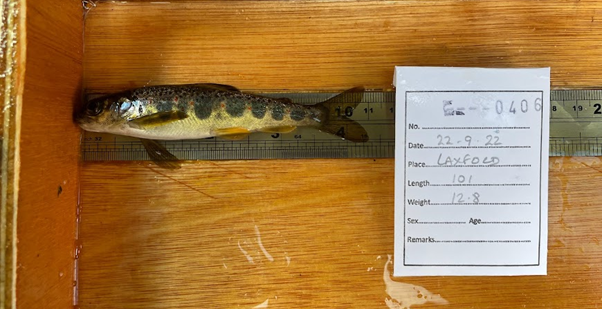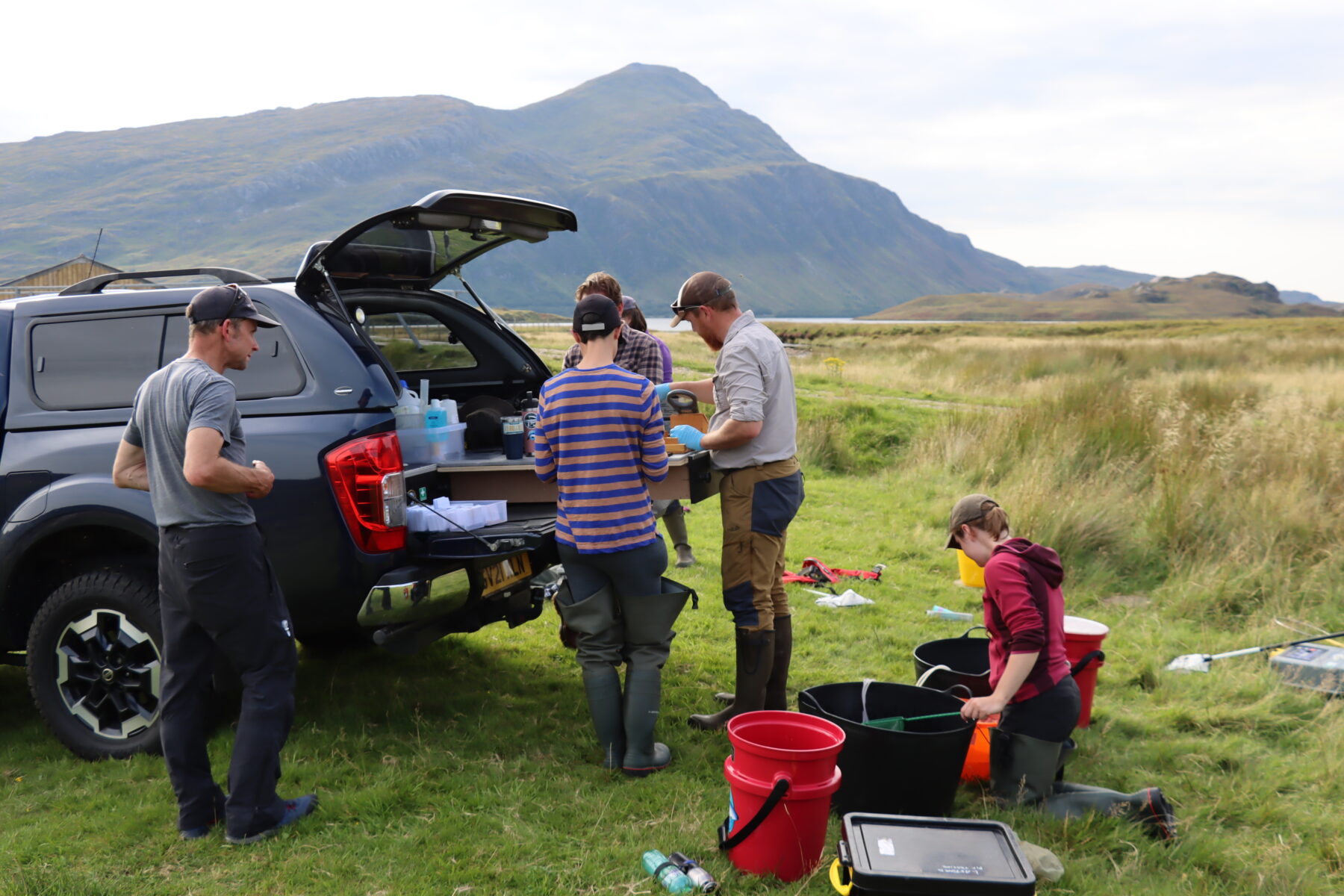From parr to smolt to adult to kelt – Project Laxford now tracking salmon across the entire lifecycle.
Project Laxford, a partnership with Grosvenor’s Reay Forest Estate, is one of two Atlantic Salmon Trust ‘Core Rivers’, the other being Project Deveron in Aberdeenshire – a partnership with the Deveron, Bogie & Isla Rivers Charitable Trust. These rivers currently represent the only two, fully monitored river systems in Scotland, linking in with the River Frome ‘index’ river in Dorset managed by our Missing Salmon Alliance partners, the Game & Wildlife Conservation Trust, and with the potential to link to a wider network of ‘index’ rivers across the North Atlantic.
Core Rivers combine catchment-scale restoration with state-of-the-art monitoring to measure the success of restoration work on wild salmon populations and the wider environment over time. One of the key monitoring methods being used is PIT (Passive Integrated Transponder) tagging – where 2,000 juvenile salmon ‘parr’ are implanted with microchip tags from both rivers each autumn, enabling us to record their movements within their home river catchment when they pass over PIT detection ‘arrays’, when they ‘smolt’ and go out to sea, and when (and if) they return as adults to spawn. PIT tagging in particular is key to measuring changes in marine survival rates over time, and how work to deliver cold, clean water for fitter, healthier smolts influences this.
We’re now gathering an incredible amount of valuable information from these two catchments to build our knowledge of how salmon populations respond to on-the-ground restoration efforts. This will not only support restoration work in these two rivers, but will also benefit other rivers across these regions and beyond.
Amongst this population-scale information being gathered, we wanted to share a snapshot of one individual fish to also demonstrate the incredible level of resolution we’re getting.
Let’s take a look at one such fish from Project Laxford, PIT tagged with ID number 3DD.003E1D8F0E on the 22nd September 2022. We’ll call him ‘Lax’…
A fishes tale
![]() The team caught Lax as a ‘parr’ when electrofishing the Laxford’s Achfary Burn on 22nd September 2022 – an important spawning burn. He was 101mm in length and weighed 12.8g. Sexing from a scale sample confirmed he was a male. He even showed signs of being a ‘precocious’ parr – a sexually mature juvenile.
The team caught Lax as a ‘parr’ when electrofishing the Laxford’s Achfary Burn on 22nd September 2022 – an important spawning burn. He was 101mm in length and weighed 12.8g. Sexing from a scale sample confirmed he was a male. He even showed signs of being a ‘precocious’ parr – a sexually mature juvenile.
After being PIT tagged, Lax was released back into the Laxford to carry on his life.

![]() The following spring, at 10:58pm on the 8th May 2023, he was detected moving downstream over the Achfary PIT detection array, as the burn flows into Loch Stack – indicating that he had ‘smolted’ and was beginning his migration out to sea. A number of spawning burns flow into Loch Stack, which then flows into and begins the River Laxford itself.
The following spring, at 10:58pm on the 8th May 2023, he was detected moving downstream over the Achfary PIT detection array, as the burn flows into Loch Stack – indicating that he had ‘smolted’ and was beginning his migration out to sea. A number of spawning burns flow into Loch Stack, which then flows into and begins the River Laxford itself.
![]() Three days later, Lax had transited through the loch and was detected on the next PIT array at the top of the Laxford’s main stem. At the time we had some intermittent issues with the final PIT array at the mouth of the river (which have since been addressed), so Lax wasn’t detected on the lowest array going out to sea.
Three days later, Lax had transited through the loch and was detected on the next PIT array at the top of the Laxford’s main stem. At the time we had some intermittent issues with the final PIT array at the mouth of the river (which have since been addressed), so Lax wasn’t detected on the lowest array going out to sea.
That was until 1 year and 2 months later…
![]() At 7:40pm on the 2nd July 2024, Lax pinged the lower array at the mouth of the river. He was back – this time as a ‘grilse’ – an adult salmon which has spent one winter at sea. He was then detected moving past the next array at the top of the Laxford at 8:27pm the following day, after which time he entered Loch Stack once again.
At 7:40pm on the 2nd July 2024, Lax pinged the lower array at the mouth of the river. He was back – this time as a ‘grilse’ – an adult salmon which has spent one winter at sea. He was then detected moving past the next array at the top of the Laxford at 8:27pm the following day, after which time he entered Loch Stack once again.
![]() Here he stayed for the next four months, before we detected him again on the Achfary Burn PIT array at 10:57am on the 13th November 2024 where he loitered for four days before moving further up the burn to spawn.
Here he stayed for the next four months, before we detected him again on the Achfary Burn PIT array at 10:57am on the 13th November 2024 where he loitered for four days before moving further up the burn to spawn.
![]() We detected him again moving downstream on 4th December, presumably on his was back down after spawning, and now as a post-spawn ‘kelt’. He once again took refuge in the loch for over two months before crossing the upper Laxford array at 10:30pm on 23rd February 2025, and passed over the lower array six hours later at 4:22am on the 24th February, making his way back to sea.
We detected him again moving downstream on 4th December, presumably on his was back down after spawning, and now as a post-spawn ‘kelt’. He once again took refuge in the loch for over two months before crossing the upper Laxford array at 10:30pm on 23rd February 2025, and passed over the lower array six hours later at 4:22am on the 24th February, making his way back to sea.
Time will tell if Lax will return again as a ‘repeat spawner’…
The power of understanding
Lax is just one of thousands of PIT tagged salmon moving throughout the Laxford and Deveron catchments, travelling out to sea, and returning as adults to spawn.
Over time, we’ll be able to build an understanding of how salmon populations respond to restoration efforts within these rivers and on the surrounding landscapes. How can we improve conditions in the spawning and nursery areas that salmon are using? How can we ensure that salmon have the cold, clean water required for good feeding to become fit and healthy smolts? How does the population respond when we remove a barrier to migration, plant trees to shade spawning streams, or restore wetlands to mitigate against floods which may wash out salmon nests or ‘redds’?
By answering these questions, Core Rivers will help to identify the solutions required to help halt the decline in wild Atlantic salmon across their range, and enable their long-term recovery.
